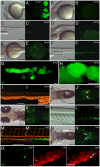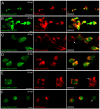The zebrafish lysozyme C promoter drives myeloid-specific expression in transgenic fish
- PMID: 17477879
- PMCID: PMC1877083
- DOI: 10.1186/1471-213X-7-42
The zebrafish lysozyme C promoter drives myeloid-specific expression in transgenic fish
Abstract
Background: How different immune cell compartments contribute to a successful immune response is central to fully understanding the mechanisms behind normal processes such as tissue repair and the pathology of inflammatory diseases. However, the ability to observe and characterize such interactions, in real-time, within a living vertebrate has proved elusive. Recently, the zebrafish has been exploited to model aspects of human disease and to study specific immune cell compartments using fluorescent reporter transgenic lines. A number of blood-specific lines have provided a means to exploit the exquisite optical clarity that this vertebrate system offers and provide a level of insight into dynamic inflammatory processes previously unavailable.
Results: We used regulatory regions of the zebrafish lysozyme C (lysC) gene to drive enhanced green fluorescent protein (EGFP) and DsRED2 expression in a manner that completely recapitulated the endogenous expression profile of lysC. Labeled cells were shown by co-expression studies and FACS analysis to represent a subset of macrophages and likely also granulocytes. Functional assays within transgenic larvae proved that these marked cells possess hallmark traits of myelomonocytic cells, including the ability to migrate to inflammatory sources and phagocytose bacteria.
Conclusion: These reporter lines will have utility in dissecting the genetic determinants of commitment to the myeloid lineage and in further defining how lysozyme-expressing cells participate during inflammation.
Figures







References
Publication types
MeSH terms
Substances
LinkOut - more resources
Full Text Sources
Molecular Biology Databases

